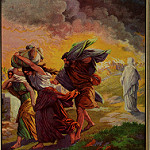Botticelli in the Fire and Sunday in Sodom, two one-act plays by Jordan Tannahill in their world premieres, are currently being performed by Canadian Stage at the Berkeley Street Theatre in Toronto. Tannahill has won the Governor General’s Award. Both new plays are modern retellings. Botticelli in the Fire focuses on a segment of the life of the Italian Renaissance painter Sandro Botticelli. Sunday in Sodom retells the story of Lot’s wife in Genesis. The Berkeley Street Theatre is a small theater in a remodeled factory building.
In both dramas, the main character looks back on his or her life and tries to explain a puzzling decision. Some scholars think that Botticelli burned several paintings in 1497 in Friar Girolamo Savonarola’s Bonfire of the Vanities because the artist found the monk’s condemnation of sin convincing. However, Tannahill’s Botticelli is a bisexual artist who has intercourse frequently with many people and uses his mistress Clarice, the wife of Lorenzo di Medici, as the model for his famous painting entitled The Birth of Venus (created 1484-1486). In this play, Botticelli destroys his paintings to save the life of his assistant and lover Leonardo da Vinci from a mob whipped into a frenzy by the demagogue Savonarola. This play includes both female (Clarice) and male (Leonardo) nudity to underscore Botticelli’s huge appetite for pleasure and sex.
Tannahill uses anachronistic props and references to twenty-first-century technologies, such as cellphones and microphones, to modernize the situation and to create humor. For example, Savanarola gets interviewed by a Florence television station about his bonfire project and his contempt for the decadent and corrupt Lorenzo di Medici. Modern sports also create humor: Lorenzo and Botticelli discuss business while playing squash.
Tannahill’s having Leonardo apprenticed to Botticelli is fictitious. As a teenager, Leonardo da Vinci was really apprenticed to the artist Andrea di Cione, known as Verrocchio, in Florence. Furthermore, Leonardo, born in 1452, was only seven years younger than Botticelli, not a much younger man as Botticelli in the Fire depicts him. Botticelli was associated with Verrocchio’s workshop, so he and Leonardo probably knew one another.
Botticelli in the Fire also has other chronological fictions. Leonardo da Vinci had left Florence by the time that Savanarola arrived in 1490: Leonardo worked in Milan from 1482 to 1499. Also, Lorenzo di Medici died in 1492 before Savanarola’s Puritanical campaign heated up. In fact, the friar’s followers expelled Lorenzo’s son Piero from Florence in 1494.
Sunday in Sodom features Lot’s wife, whom Tannahill names Edith, explaining her frustrating life to us. As the play opens, we hear noise and feel vibrations from the ongoing war nearby. Edith introduces us to her husband Lot and their daughter Sahrah, who has two young children and is in graduate school. The family takes in a badly wounded soldier named Chris and his comrade Derek.
Note that in Genesis, Lot and his wife have two virgin daughters before the fall of Sodom, so Tannahill is altering the Biblical narrative. Other alterations include replacing angels with soldiers, Sahrah’s typing on a computer to do her college homework, and Isaac’s using a cell phone to contact Edith for help after Abraham tries to sacrifice him.
Townspeople come to Lot and Edith’s home to harass the soldiers, so the two men leave. Derek returns later to warn Edith and Lot that the army will retaliate for the crowd’s hostility by bombing Sodom. Derek urges the family to flee and not look back. Most family members leave the house, but Sahrah remains, searching for her missing child. Edith looks back, worried about her only daughter, and turns into a pillar of salt. This interpretation represents Lot’s wife much more sympathetically than the Biblical narrative does. Because war is raging across the Middle East in 2016, Sunday in Sodom has a lot of contemporary resonance.
Tannahill’s scripts call for six actors for both plays, and the Canadian Stage’s production double-casts the same actors for the two dramas. This is a grueling job for the cast members, but they all rise to meet the challenge. Salvatore Antonio portrays Botticelli and Chris; Valerie Buhagiar portrays Madre Maria and Edith; Nicola Correia-Damude portrays Clarice and Sahrah; Stephen Jackman-Torkoff portrays Leonardo and Isaac; Christopher Morris portrays Lorenzo and Derek; and Alon Nashman portrays Savanarola and Lot. Salvatore Antonio captures Botticelli’s gusto for life and handles the artist’s many lines very well. Valerie Buhagiar does an excellent job with Edith’s long monologues. Matjash Mrozewski directed Botticelli in the Fire, and Estelle Shook directed Sunday in Sodom.
Both plays are thought-provoking and well worth seeing. The last performance is May 15, 2016.

Photos by Internet Archive Book Images,
Janet, it is always a pleasure to read your reviews, as well as, your poems and so enjoy your children’s books. Keep producing those great stories.
Thank Janet for your well written reviews, giving me a vicarious trip to a place I have not known… and its style of expression.
This was a detailed review about the original facts or stories and how they were “twisted” in the new plays. The question not answered here is: what is the meaning of each play? The work of play writer, actors, director, stage manager etc. must have been to “carry” some meaning.
Dear Esther,
I’m not sure that either play has deep meaning. That is my criticism of a lot of modern dramas: they are interesting but not profound. I think that the playwright simply tried to provide alternative and more sympathetic explanations for the main characters’ puzzling choices. Tannahill portrays the (apocryphal) homosexual relationship between Leonardo and Botticelli as intense and important to both men. Similarly, Tannahill emphasizes the love of Edith (Lot’s wife) for her daughter.
Best wishes! Janet